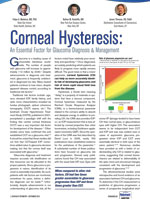Corneal Hysteresis: An Essential Factor for Glaucoma Diagnosis & Management
Read Digital Edition
Read PDF Edition
Sponsored by Reichert
Glaucoma diagnosis and treatment requires accurate risk stratifi cation so that resources can be allocated to the proper patients. Since glaucoma is progressive in nature, identification of its onset is essentially impossible. As such, patients with risk factors are monitored, sometimes for years, before a definitive diagnosis can be made. Unfortunately, despite advancements in our understanding of glaucoma risk, all the factors noted have relatively poor sensitivity and specificity. Once diagnosed, accurately predicting which patients are likely to progress more rapidly remains difficult. The good news is that a newer parameter, corneal hysteresis can help us more accurately identify risk of developing glaucoma and risk of more rapid visual field loss from the disease.
Glaucoma diagnosis and treatment requires accurate risk stratifi cation so that resources can be allocated to the proper patients. Since glaucoma is progressive in nature, identification of its onset is essentially impossible. As such, patients with risk factors are monitored, sometimes for years, before a definitive diagnosis can be made. Unfortunately, despite advancements in our understanding of glaucoma risk, all the factors noted have relatively poor sensitivity and specificity. Once diagnosed, accurately predicting which patients are likely to progress more rapidly remains difficult. The good news is that a newer parameter, corneal hysteresis can help us more accurately identify risk of developing glaucoma and risk of more rapid visual field loss from the disease.
Additional Publications
-
Annual Contact Lenses and Lens Care Guide-2022
Hear from several experts, including Miguel A. Busquets, MD, Carolyn Majcher, OD, and Mary Anne C. Murphy, OD, about how to manage geographic atrophy using modern-day tools, technology, treatments and knowledge.
Sponsored by Apellis Pharmaceuticals Inc and Carl Zeiss Meditec USA, Inc Clinical Perspectives on Patient Care
Digital Devices are Impacting Your Patients
Opthalmic Product Guide
Practical Matters in Myopia Management
Innovations in Glaucoma Care & Treatment



